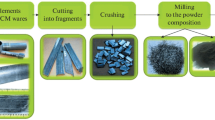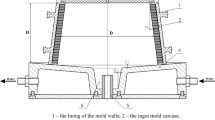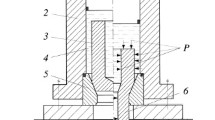Abstract
The piercing of aluminium ingots (made by permanent mold gravity casting) is done in a Mannesmann rolling mill with supporting shoe using plugs of various shapes with a spherical working part: an entire plug, a plug with cavity, and a hollow plug. The calibrating segments of the plugs have identical diameters. The piercing is carried out at an ingot temperature of 400°C. The influence of the plug shape on the variation in the outer hollow shell diameter and wall thickness along the shell length, as well as shell density over the length, is investigated. Hollow shells were cut into 15 equal rings to measure density using hydrostatic weighing. Experimental investigations are simulated with the help of the finite-element method (FEM) computer software. Ingot fabrication by permanent mold gravity casting is simulated using the ProCAST software and piercing—using the QForm software. The variation in the hollow shell diameter, wall thickness, and shell density along the length is also evaluated by computer simulation. Experimental and simulation data are compared to verify the adequacy of acquired models in the QForm. The difference in density does not exceed 2% and, for hollow shell dimensions, 20%. These results make it possible to establish the influence of the piercing plug shape on the accuracy of the shells and their density. It is most preferable to use a hollow plug or a plug with a cavity from the viewpoint of dimension accuracy of fabricated shells. Each of these piercing schematics makes it possible to densify the entire hollow shell volume to the true density, except for the near-edge domains, where the density is lower by 1%.








Similar content being viewed by others
REFERENCES
Erman, E., The effect of processing parameters on the propensity for central fracturing in piercing, J. Appl. Metalwork, 1987, vol. 4, no. 4, pp. 331–341.
Galkin, S.P., Radial shear rolling as an optimal technology for lean production, Steel Trans., 2014, vol. 44, no. 1, pp. 61–64.
Korol’, A.V., Vydrin, A.V., and Shirokov, V.V., Computer simulation of piercing in a screw mill with barrel-rolling rolls, Vestn. Yuzh.-Utal. Gos. Univ. Ser. Metall., 2015, vol. 15, no. 2, pp. 68–64.
Joun, M., Lee, J., Cho, J., Jeong, S., and Moon, H., Quantitative study on Mannesmann effect in roll piercing of hollow shaft, Proc. Eng., 2014, vol. 81, pp. 197–202.
Lu, L., Wang, Z., Wang, F., Zhu, G., and Zhang, X., Simulation of tube forming process in Mannesmann mill, J. Shanghai Jiaotong Univ. (Sci.), 2011, vol. 16, no. 3, pp. 281–285.
Pater, Z. and Kazanecki, J., Complex numerical analysis of the tube forming process using Diescher mill, Arch. Metall. Mater., 2013, vol. 58, no. 3, pp. 717–724.
Berazategui, D.A., Cavaliere, M.A., Montelatici, L., and Dvorkin, E.N., On the modelling of complex 3D bulk metal forging processes via the pseudo-concentration technique. Application to the simulation of the Mannesmann piercing process, Int. J. Numer Methods Eng., 2006, vol. 65, no. 7, pp. 1113–1144.
Yoshida, M., Barlat, F., Moon, Y.H., and Lee, M.G., 3D FEM simulation of rolling load working on piercer plug in mannesmann piercing process, AIP Conf. Proc., 2010, vol. 1252, no. 1, pp. 1333–1338.
Nikulin, A.N., Vintovaya prokatka. Napryazheniya i deformatsii (Screw Rolling. Stresses and Strains), Moscow: Metallurgizdat, 2015.
Jaouen, O., Costes, F., and Lasne, P.m A new 3D simulation model for complete chaining casted and forged ingot, in: Proc. 1st Int. Conf. on Ingot Casting, Rolling, and Forging, Germany, Aachen: Stahleisen, 2012, pp. 1–9.
De Micheli, P., Settefrati, A., Marie, S., Barlier, J., and Lasne P. Towards the simulation of the whole manufacturing chain processes with FORGE®, in: Proc. Int. Conf. on New Development in Forging Technology, Germany, Stuttgart: Inventum, 2015, pp. 1–25.
Skripalenko, M.M., Bazhenov, V.E., Romantsev, B.A., Skripalenko, M.N., Koltygin, A.V., and Sidorov, A.A., Computer modeling of chain processes in the manufacture of metallurgical products, Metallurgist, 2014, vol. 58, nos. 1–2, pp. 86–90.
Abdullin, A.D. and Ershov, A.A., End-to-end simulation of casting and metal-forming operations with ProCAST and QForm software, Metallurgist, 2014, vol. 58, nos. 5–6, pp. 339–345.
Skripalenko, M.M., Bazhenov, V.E., Romantsev, B.A., Skripalenko, M.N., Huy, T.B., and Gladkov, Y.A., Mannesmann piercing of ingots by plugs of different shapes, Mater. Sci. Technol., 2016, vol. 32, pp. 1712–1720.
Bazhenov, V.E., Koltygin, A.V., Tselovalnik, Yu.V., and Sannikov, A.V., Determination of interface heat transfer coefficient between aluminum casting and graphite mold, Russ. J. Non-Ferrous Met., 2017, vol. 58, no. 2, pp. 114–123.
Bazhenov, V.E., Koltygin, A.V., and Tselovalnik, Yu.V., Determination of the heat-transfer coefficient between the AK7ch (A356) alloy casting and no-bake mold, Russ. J. Non-Ferrous Met., 2016, vol. 57, no. 7, pp. 686–694.
QForm Software Home Page. http://qform3d.ru (accessed November 13, 2017).
Modelling of the Mannesmann effect in tube piercing—Padua@Research (Padova Digital Univ. Archive). http://paduaresearch.cab.unipd.it/1552/ (accessed November 17, 2017).
Lemaitre, J. and Desmorat, R., Engineering Damage Mechanics, Berlin: Springer, 2005.
Lemaitre, J., A continuous damage mechanics model for ductile fracture, J. Eng. Mater. Technol., 1985, vol. 107, no. 1, pp. 83–89.
Chiluveru, S., Computational modeling of crack initiation in crossroll piercing, PhD Thesis, Massachusetts: Massachusetts Inst. Technol., 2007.
Karpov, B.V., Skripalenko, M.M., Galkin, S.P., Skripalenko, M.N., Samusev, S.V., Huy, T.B., and Pavlov, S.A., Studying the nonstationary stages of screw rolling of billets with profiled ends, Metallurgist, 2017, vol. 61, nos. 3–4, pp. 257–264.
Author information
Authors and Affiliations
Corresponding authors
Additional information
Translated by N. Korovin
About this article
Cite this article
Skripalenko, M.M., Romantsev, B.A., Bazhenov, V.E. et al. Computer Simulation of Mannesmann Piercing of Aluminium Alloy Ingots. Russ. J. Non-ferrous Metals 60, 27–34 (2019). https://doi.org/10.3103/S1067821219010127
Received:
Revised:
Accepted:
Published:
Issue Date:
DOI: https://doi.org/10.3103/S1067821219010127




